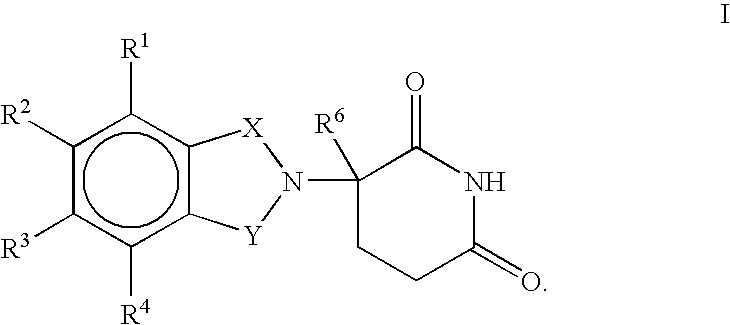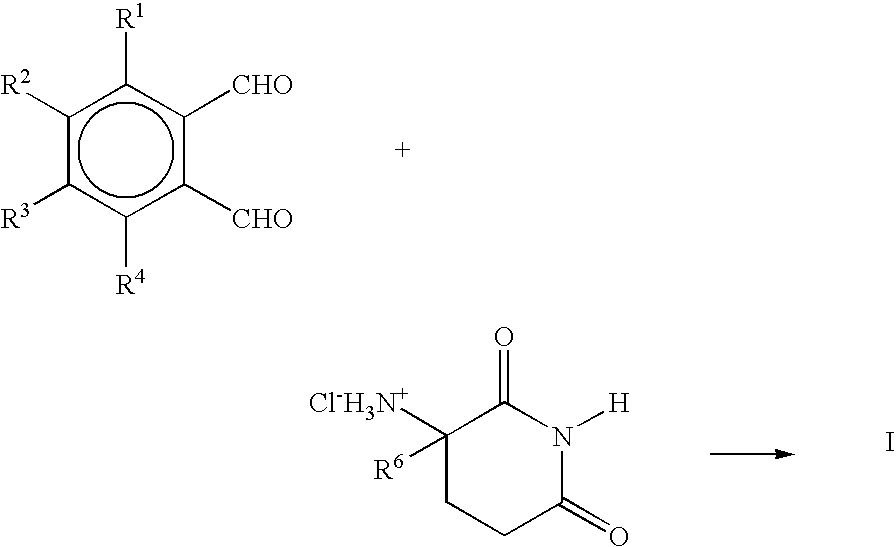Methods for the treatment of cachexia
a cachexia and treatment method technology, applied in the field of cachexia treatment methods, can solve the problems of impaired t-cell mediated immunity and severe opportunistic infections of infected individuals
- Summary
- Abstract
- Description
- Claims
- Application Information
AI Technical Summary
Benefits of technology
Problems solved by technology
Method used
Image
Examples
example 1
1,3-Dioxo-2-(2,6-dioxopiperidin-3-yl)-5-aminoisoindoline
[0049] A mixture of 1,3-ioxo-2-(2,6-dioxopiperidin-3-yl)-5-nitroisoindoline {alternatively named as N-(2,6-dioxopiperidin-3-yl)-4-nitrophthalimide} (1 g, 3.3 mmol) and 10% Pd / C (0.13 g) in 1,4-dioxane (200 mL) was hydrogenated at 50 psi for 6.5 hours. The catalyst was filtered through Celite and the filtrate concentrated in vacuo. The residue was crystallized from ethyl acetate (20 mL) to give 0.62 g (69%) of 1,3-dioxo-2-(2,6-dioxopiperidin-3-yl)-5-aminoisoindoline {alternatively named as N-(2,6-dioxopiperidin-3-yl)4-aminophthalimide} as an orange solid. Recrystallization from dioxane / ethyl acetate gave 0.32 g of yellow solid: mp 318.5-320.5° C.; HPLC (nova Pak C18,15 / 85 acetonitrile / 0.1% H3PO4) 3.97 min (98.22%): 1H NMR (DMSO-d6) δ 11.08(s, 1H), 7.53-7.50 (d, J=8.3 Hz, 1H), 6.94(s, 1H), 6.84-6.81(d, J=8.3 Hz,1H), 6.55(s,2H). 5.05-4.98(m, 1H), 2.87-1.99(m. 4H); 13C NMR (DMSO-d6) δ 172.79, 170.16, 167.65, 167.14, 155.23, 134.21...
example 2
1,3-Dioxo-2-(2,6dioxopiperidin-3-yl)-5-nitroisoindoline
[0051] A mixture of 4-nitrophthalic anhydride (1.7 g, 8.5 mmol), α-aminoglutarimide hydrochloride (1.4 g, 8.5 mmol) and sodium acetate (0.7 g, 8.6 mmol) in glacial acetic acid (30 mL) was heated under reflux for 17 hours. The mixture was concentrated in vacuo and the residue was stirred with methylene chloride (40 mL) and water (30 mL). The aqueous layer was separated, extracted with methylene chloride (2×40 mL). The combined methylene chloride solutions were dried over magnesium sulfate and concentrated in vacuo to give 1.4 g (54%) of 1,3-dioxo-2-(2,6-dioxopiperidin-3-yl)-5-nitroisoindoline as a light brown solid. An analytical sample was obtained by recrystallization from methanol: mp 228.5-229.5° C.; 1H NMR (DMSO-d6) δ 11.18(s, 1 H), 8.69-8.65(d,d J=1.9 and 8.0 Hz, 1H), 8.56(d, J=1.9 Hz, 1H), 8.21(d, H=8.2 Hz, 1H), 5.28(d,d J=5.3 and 12.8 Hz, 1H), 2.93-2.07(m, 4H); 13C NMR (DMSO-d6) δ 172.66, 169.47, 165.50, 165.23, 151.69, ...
example 3
1-Oxo-2-(2,6-dioxopiperidin-3-yl)-4,5,6,7-tetranfuoroisoindoline
[0053] A mixture of 16.25 g of 2,6-dioxopiperidin-3-ammonium chloride, and 30.1 g of methyl 2-bromomethyl-3,4,5,6-tetrafluorobenzoate, and 12.5 g of triethylamine in 100 mL of dimethylformamide is stirred at room temperature for 15 hours. The mixture is then concentrated in vacuo and the residue mixed with methylene chloride and water. The aqueous layer is separated and back-extracted with methylene chloride. The combined methylene chloride solutions are dried over magnesium sulfate and concentrated in vacuo to give 1-oxo-2-(2,6-dioxopiperidin-3-yl)-4,5,6,7-tetrafluoroisoindoline.
[0054] In a similar fashion 1-oxo2-(2,6-dioxopiperidin-3-yl)-4,5,6,7-tetrachloroisoindoline, 1-oxo-2-(2,6-dioxopiperidin-3-yl)-4,5,6,7-tetramethylisoindoline, and 1-oxo-2-(2,6-dioxopiperidin-3-yl)-4,5,6,7-tetramethoxyisoindoline are obtained by substituting equivalent amounts of 2-bromomethyl-3,4,5,6-tetrachlorobenzoate, 2-bromomethyl-3,4,5,6...
PUM
| Property | Measurement | Unit |
|---|---|---|
| concentration | aaaaa | aaaaa |
| temperature | aaaaa | aaaaa |
| pH | aaaaa | aaaaa |
Abstract
Description
Claims
Application Information
 Login to View More
Login to View More - R&D
- Intellectual Property
- Life Sciences
- Materials
- Tech Scout
- Unparalleled Data Quality
- Higher Quality Content
- 60% Fewer Hallucinations
Browse by: Latest US Patents, China's latest patents, Technical Efficacy Thesaurus, Application Domain, Technology Topic, Popular Technical Reports.
© 2025 PatSnap. All rights reserved.Legal|Privacy policy|Modern Slavery Act Transparency Statement|Sitemap|About US| Contact US: help@patsnap.com



